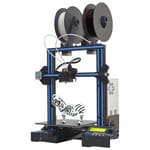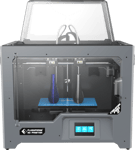Dual extrusion 3D printers used to be too expensive for most makers. Things are changing though, and more affordable dual-wielding 3D printers are now fighting for your attention.
The Tenlog TL-D3 Pro is one of them. What’s more, it has an IDEX system. IDEX (Independant Dual Extrusion) allows the two print heads to operate independently from one another along the X-axis, and, simply put, that means you can get even fancier with your prints.
Combined with a decent 300 x 300 x 350 mm-sized print bed and a competitive asking price of ~$600, this printer seems to be ranking highly as a value proposition, making it quite interesting not just for hobbyists, but even small and medium-sized companies.
We took a look at the printer’s specs to see if it is worth the hype.
Features

IDEX
The Tenlog TL-D3 Pro comes with an independent dual extruder system (IDEX), a rarity in its price class. This means it has two extruders capable of 3D printing that can move independently along the X-axis, allowing for dual-color or multi-material prints and even the use of soluble support structures.
With the two extruder heads moving independently, you can also print two items simultaneously using duplication or mirror print modes. With a print volume of 300 x 300 x 350 mm, the printer should house enough space for your creations. Bear in mind, though, in either duplication or mirror mode, the print volume effectively gets cut in half.
Direct Drive
The TL-D3 Pro uses direct drive extruders for both its printheads. Having a direct drive setup does have some benefits, one being better filament retraction, theoretically lessening the chances of stringing and oozing during prints. In multi-material or multi-color prints with a lot of retraction left and right, this could come in quite handy.
Direct drive setups also have the potential to handle flexible filaments a bit better. And for a printer like the TL-D3 Pro, it’s likely flexible filaments will be on users’ menus, as well as the usual array of consumer filaments, including PLA, ABS, and PETG.
Heated Print Plate
This is pretty much a standard feature on any contemporary 3D printer and is particularly important if you want to handle the array of filaments the TL-D3 Pro is set up for.
The TL-3D Pro comes with a heated bed capable of reaching temperatures of up to 80 °C, according to the manufacturer. This should provide proper adhesion for most filaments, and a good variety there will probably be, as the hot ends above can reach 300 °C, more than enough for most.
Older Tenlog TL-D3 Pro machines can be found online with simple, plain glass for the print bed surface. Recently, however, it has been upgraded to a borosilicate glass bed, which should provide better adhesion and less warping, mitigating the need to use glue, tape, or any other adhesive, as well as allow for the easy removal of prints once the plate has cooled down.
Sensors
Filament runout detection sensors and a resume power out function have also become commonly fitted components to 3D printers in the last few years. Nonetheless, it is nice to see them included on the TL-D3 Pro, as with its large build volume and dual printing modes, long print times might be on the agenda. There is nothing worse than coming back to a 20-hour print just to see that the filament ran out somewhere along the way. With the TL-3D Pro’s sensors, this is an experience you shouldn’t have to go through.
Further Features
Additional features on the Tenlog TL-D3 Pro include:
- Touchscreen – The printer comes with a 4.3-inch color touch screen display, and all the printer controls are dealt with from there.
- Silent Stepper Drivers – The TL-D3 Pro’s motherboard supports both TMC2208 and the TMC2225 stepper drivers, which should keep the printer’s operational noise level down.
- Easy Assembly – the TL-D3 Pro comes partially assembled and should be easy to install for most people.

Price
The Tenlog TL-D3 Pro is currently available for ~$600, and it’s rare to see an IDEX machine for that price. Typically independent dual extruder systems are harder to find on printers geared towards consumers and hobbyist machines for this sort of money.
There are pricier, more versatile IDEX printers out there if you plan on using one professionally. Still, with its multi-material capabilities, large build volume, and very competitive price, the TL-D3 Pro is an attractive option for hobbyists and tinkerers that want to try out dual material printing.

Reviews
Since the Tenlog TL-D3 Pro has been around for a while, a fairly decent amount of reviews on the usual platforms, YouTube and the like, can be found online.
In general, users seem to quite like the machine but have reported that it will need a bit of dialing in. The calibration of the printer heads in particular can be tricky for beginners. Once properly lined up, the printer can put out quite an impressive array of prints.

Tech Specs

General Specifications
- Technology: Fused deposition modeling (FDM)
- Year: 2020
- Assembly: Partially assembled
- Mechanical arrangement: Cartesian-XZ-heads
- Manufacturer: Tenlog
3D Printer Properties
- Build volume: 300 x 300 x 350 mm
- Feeder system: Direct drive
- Print head: IDEX
- Nozzle size: 0.4 mm
- Max. hot end temperature: 300 ℃
- Max. heated bed temperature: 110 ℃
- Print bed material: Tempered glass
- Frame: Aluminum
- Bed leveling: Manual
- Connectivity: SD card
- Print recovery: Yes
- Filament sensor: Yes
- Camera: No
Materials
- Filament diameter: 1.75 mm
- Third-party filament: Yes
- Filament materials: Consumer materials (PLA, ABS, PETG, Flexibles)
Software
- Recommended slicer: Cura, Repetier-Host
- Operating system: Windows XP, 7, 8, 10, Linux
- File types: STL, OBJ, AMF, G-code
Dimensions and Weight
- Frame dimensions: 590 x 520 x 760 mm
- Weight: 15.6 kg

Similar Printers
You may also be interested in the following printers:
For further information, feel free to check out our Best Budget Dual Extruder Guide
Geeetech A10M
An even cheaper option. The A10M uses a single nozzle setup with a “Y-splitter”, which merges the two materials and deposits a single strand. This allows for single color, multi-color, graded color, and mixed color prints. Multi-material prints or the use of soluble support are off the table, though.
With a 220 x 220 x 260 mm build volume and a sub-$300 price tag, it is a viable option for users that just want to mix colors and not materials.
Flashforge Creator Pro 2
The Creator Pro 2 is another IDEX printer. Its print volume of 200 x 148 x 150 mm can be considered a bit small by modern standards, but the enclosed build chamber gives you the ability to print with more filaments. Combined with the ease of use and quality it offers out of the box, the Creator Pro 2 is more than a solid recommendation for hobbyists and people looking for a more professional machine.
License: The text of "Tenlog TL-D3 Pro: Specs, Price, Release & Reviews" by All3DP is licensed under a Creative Commons Attribution 4.0 International License.
CERTAIN CONTENT THAT APPEARS ON THIS SITE COMES FROM AMAZON. THIS CONTENT IS PROVIDED ‘AS IS’ AND IS SUBJECT TO CHANGE OR REMOVAL AT ANY TIME.



